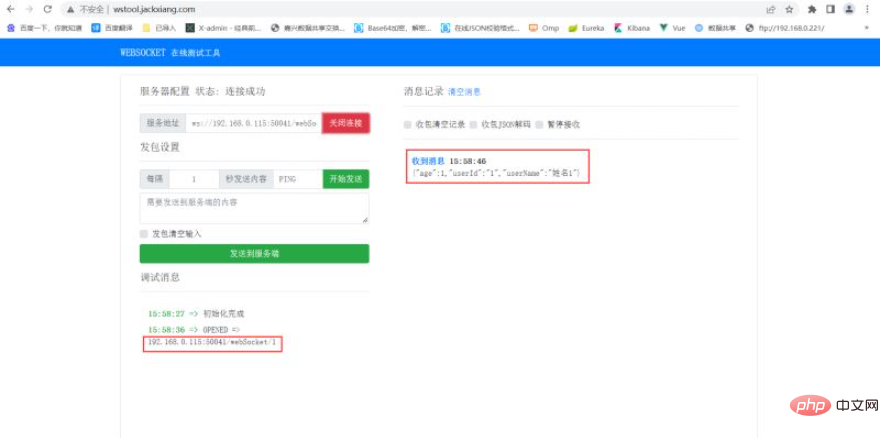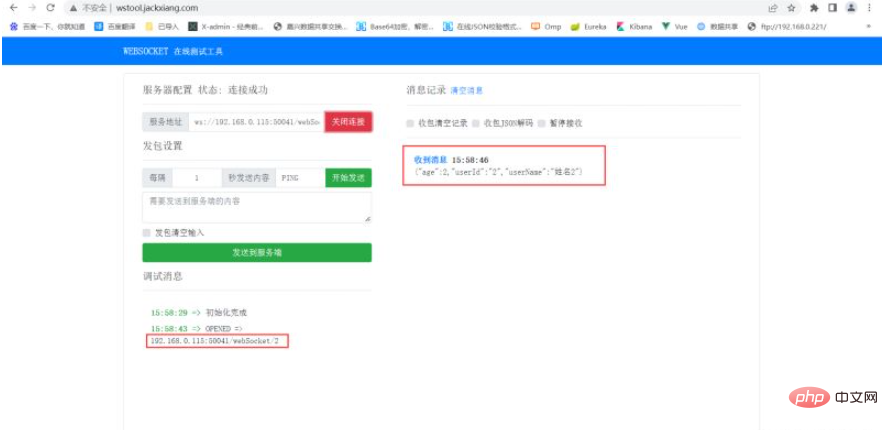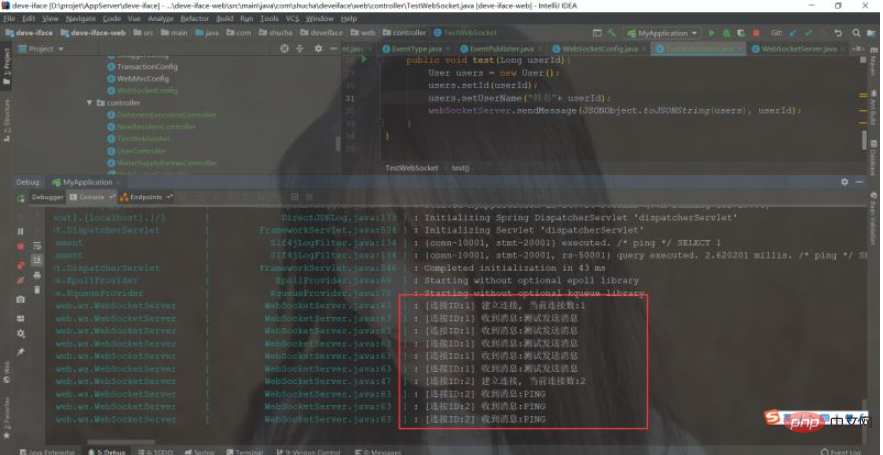How SpringBoot implements WebSocket instant messaging
1. Introducing dependencies
<dependency> <groupId>org.springframework.boot</groupId> <artifactId>spring-boot-starter-websocket</artifactId> </dependency> <dependency> <groupId>org.projectlombok</groupId> <artifactId>lombok</artifactId> </dependency> <dependency> <groupId>com.alibaba</groupId> <artifactId>fastjson</artifactId> <version>1.2.3</version> </dependency>
2. WebSocketConfig turns on WebSocket
package com.shucha.deveiface.web.config;
/**
* @author tqf
* @Description
* @Version 1.0
* @since 2022-04-12 15:35
*/
import org.springframework.context.annotation.Bean;
import org.springframework.context.annotation.Configuration;
import org.springframework.web.socket.server.standard.ServerEndpointExporter;
/**
* 开启WebSocket
*/
@Configuration
public class WebSocketConfig {
@Bean
public ServerEndpointExporter serverEndpointExporter(){
return new ServerEndpointExporter();
}
}3. WebSocketServer
package com.shucha.deveiface.web.ws;
/**
* @author tqf
* @Description
* @Version 1.0
* @since 2022-04-12 15:33
*/
import lombok.extern.slf4j.Slf4j;
import org.springframework.stereotype.Component;
import org.springframework.web.socket.WebSocketSession;
import javax.websocket.*;
import javax.websocket.server.PathParam;
import javax.websocket.server.ServerEndpoint;
import java.util.ArrayList;
import java.util.Collections;
import java.util.List;
import java.util.concurrent.ConcurrentHashMap;
import java.util.concurrent.CopyOnWriteArraySet;
@Component
@ServerEndpoint("/webSocket/{userId}")
@Slf4j
public class WebSocketServer {
private Session session;
private String userId;
/**静态变量,用来记录当前在线连接数。应该把它设计成线程安全的。*/
private static int onlineCount = 0;
private static CopyOnWriteArraySet<WebSocketServer> webSocketSet = new CopyOnWriteArraySet<>();
/**
* concurrent包的线程安全set,用来存放每个客户端对应的MyWebSocket对象
*/
private static ConcurrentHashMap<String,WebSocketServer> webSocketMap = new ConcurrentHashMap();
/**
* 为了保存在线用户信息,在方法中新建一个list存储一下【实际项目依据复杂度,可以存储到数据库或者缓存】
*/
private final static List<Session> SESSIONS = Collections.synchronizedList(new ArrayList<>());
/**
* 建立连接
* @param session
* @param userId
*/
@OnOpen
public void onOpen(Session session, @PathParam("userId") String userId) {
this.session = session;
this.userId = userId;
webSocketSet.add(this);
SESSIONS.add(session);
if (webSocketMap.containsKey(userId)) {
webSocketMap.remove(userId);
webSocketMap.put(userId,this);
} else {
webSocketMap.put(userId,this);
addOnlineCount();
}
// log.info("【websocket消息】有新的连接, 总数:{}", webSocketSet.size());
log.info("[连接ID:{}] 建立连接, 当前连接数:{}", this.userId, webSocketMap.size());
}
/**
* 断开连接
*/
@OnClose
public void onClose() {
webSocketSet.remove(this);
if (webSocketMap.containsKey(userId)) {
webSocketMap.remove(userId);
subOnlineCount();
}
// log.info("【websocket消息】连接断开, 总数:{}", webSocketSet.size());
log.info("[连接ID:{}] 断开连接, 当前连接数:{}", userId, webSocketMap.size());
}
/**
* 发送错误
* @param session
* @param error
*/
@OnError
public void onError(Session session, Throwable error) {
log.info("[连接ID:{}] 错误原因:{}", this.userId, error.getMessage());
error.printStackTrace();
}
/**
* 收到消息
* @param message
*/
@OnMessage
public void onMessage(String message) {
// log.info("【websocket消息】收到客户端发来的消息:{}", message);
log.info("[连接ID:{}] 收到消息:{}", this.userId, message);
}
/**
* 发送消息
* @param message
* @param userId
*/
public void sendMessage(String message,Long userId) {
WebSocketServer webSocketServer = webSocketMap.get(String.valueOf(userId));
if (webSocketServer!=null){
log.info("【websocket消息】推送消息, message={}", message);
try {
webSocketServer.session.getBasicRemote().sendText(message);
} catch (Exception e) {
e.printStackTrace();
log.error("[连接ID:{}] 发送消息失败, 消息:{}", this.userId, message, e);
}
}
}
/**
* 群发消息
* @param message
*/
public void sendMassMessage(String message) {
try {
for (Session session : SESSIONS) {
if (session.isOpen()) {
session.getBasicRemote().sendText(message);
log.info("[连接ID:{}] 发送消息:{}",session.getRequestParameterMap().get("userId"),message);
}
}
} catch (Exception e) {
e.printStackTrace();
}
}
/**
* 获取当前连接数
* @return
*/
public static synchronized int getOnlineCount() {
return onlineCount;
}
/**
* 当前连接数加一
*/
public static synchronized void addOnlineCount() {
WebSocketServer.onlineCount++;
}
/**
* 当前连接数减一
*/
public static synchronized void subOnlineCount() {
WebSocketServer.onlineCount--;
}
}4. Test the connection to send and receive messages
package com.shucha.deveiface.web.controller;
import com.alibaba.fastjson.JSONObject;
import com.shucha.deveiface.web.ws.WebSocketServer;
import lombok.Data;
import lombok.experimental.Accessors;
import org.springframework.beans.factory.annotation.Autowired;
import org.springframework.web.bind.annotation.GetMapping;
import org.springframework.web.bind.annotation.RequestMapping;
import org.springframework.web.bind.annotation.RestController;
/**
* @author tqf
* @Description
* @Version 1.0
* @since 2022-04-12 15:44
*/
@RestController
@RequestMapping("/web")
public class TestWebSocket {
@Autowired
private WebSocketServer webSocketServer;
/**
* 消息发送测试
*/
@GetMapping("/test")
public void test(){
for (int i=1;i<4;i++) {
WebsocketResponse response = new WebsocketResponse();
response.setUserId(String.valueOf(i));
response.setUserName("姓名"+ i);
response.setAge(i);
webSocketServer.sendMessage(JSONObject.toJSONString(response), Long.valueOf(String.valueOf(i)));
}
}
/**
* 群发消息测试(给当前连接用户发送)
*/
@GetMapping("/sendMassMessage")
public void sendMassMessage(){
WebsocketResponse response = new WebsocketResponse();
response.setUserName("群发消息模板测试");
webSocketServer.sendMassMessage(JSONObject.toJSONString(response));
}
@Data
@Accessors(chain = true)
public static class WebsocketResponse {
private String userId;
private String userName;
private int age;
}
}5. Online test address
websocket Online test
6. Test screenshot
Access test to send message: http://localhost:50041//web/ test
Test access address: ws://192.168.0.115:50041/webSocket/1 wss://192.168.0.115:50041/webSocket/2



The above is the detailed content of How SpringBoot implements WebSocket instant messaging. For more information, please follow other related articles on the PHP Chinese website!

Hot AI Tools

Undresser.AI Undress
AI-powered app for creating realistic nude photos

AI Clothes Remover
Online AI tool for removing clothes from photos.

Undress AI Tool
Undress images for free

Clothoff.io
AI clothes remover

AI Hentai Generator
Generate AI Hentai for free.

Hot Article

Hot Tools

Notepad++7.3.1
Easy-to-use and free code editor

SublimeText3 Chinese version
Chinese version, very easy to use

Zend Studio 13.0.1
Powerful PHP integrated development environment

Dreamweaver CS6
Visual web development tools

SublimeText3 Mac version
God-level code editing software (SublimeText3)

Hot Topics
 The combination of Java and WebSocket: how to achieve real-time video streaming
Dec 17, 2023 pm 05:50 PM
The combination of Java and WebSocket: how to achieve real-time video streaming
Dec 17, 2023 pm 05:50 PM
With the continuous development of Internet technology, real-time video streaming has become an important application in the Internet field. To achieve real-time video streaming, the key technologies include WebSocket and Java. This article will introduce how to use WebSocket and Java to implement real-time video streaming playback, and provide relevant code examples. 1. What is WebSocket? WebSocket is a protocol for full-duplex communication on a single TCP connection. It is used on the Web
 How to achieve real-time communication using PHP and WebSocket
Dec 17, 2023 pm 10:24 PM
How to achieve real-time communication using PHP and WebSocket
Dec 17, 2023 pm 10:24 PM
With the continuous development of Internet technology, real-time communication has become an indispensable part of daily life. Efficient, low-latency real-time communication can be achieved using WebSockets technology, and PHP, as one of the most widely used development languages in the Internet field, also provides corresponding WebSocket support. This article will introduce how to use PHP and WebSocket to achieve real-time communication, and provide specific code examples. 1. What is WebSocket? WebSocket is a single
 Combination of golang WebSocket and JSON: realizing data transmission and parsing
Dec 17, 2023 pm 03:06 PM
Combination of golang WebSocket and JSON: realizing data transmission and parsing
Dec 17, 2023 pm 03:06 PM
The combination of golangWebSocket and JSON: realizing data transmission and parsing In modern Web development, real-time data transmission is becoming more and more important. WebSocket is a protocol used to achieve two-way communication. Unlike the traditional HTTP request-response model, WebSocket allows the server to actively push data to the client. JSON (JavaScriptObjectNotation) is a lightweight format for data exchange that is concise and easy to read.
 SSE and WebSocket
Apr 17, 2024 pm 02:18 PM
SSE and WebSocket
Apr 17, 2024 pm 02:18 PM
In this article, we will compare Server Sent Events (SSE) and WebSockets, both of which are reliable methods for delivering data. We will analyze them in eight aspects, including communication direction, underlying protocol, security, ease of use, performance, message structure, ease of use, and testing tools. A comparison of these aspects is summarized as follows: Category Server Sent Event (SSE) WebSocket Communication Direction Unidirectional Bidirectional Underlying Protocol HTTP WebSocket Protocol Security Same as HTTP Existing security vulnerabilities Ease of use Setup Simple setup Complex performance Fast message sending speed Affected by message processing and connection management Message structure Plain text or binary Ease of use Widely available Helpful for WebSocket integration
 PHP and WebSocket: Best practices for real-time data transfer
Dec 18, 2023 pm 02:10 PM
PHP and WebSocket: Best practices for real-time data transfer
Dec 18, 2023 pm 02:10 PM
PHP and WebSocket: Best Practice Methods for Real-Time Data Transfer Introduction: In web application development, real-time data transfer is a very important technical requirement. The traditional HTTP protocol is a request-response model protocol and cannot effectively achieve real-time data transmission. In order to meet the needs of real-time data transmission, the WebSocket protocol came into being. WebSocket is a full-duplex communication protocol that provides a way to communicate full-duplex over a single TCP connection. Compared to H
 WebSocket and JavaScript: key technologies for implementing real-time monitoring systems
Dec 17, 2023 pm 05:30 PM
WebSocket and JavaScript: key technologies for implementing real-time monitoring systems
Dec 17, 2023 pm 05:30 PM
WebSocket and JavaScript: Key technologies for realizing real-time monitoring systems Introduction: With the rapid development of Internet technology, real-time monitoring systems have been widely used in various fields. One of the key technologies to achieve real-time monitoring is the combination of WebSocket and JavaScript. This article will introduce the application of WebSocket and JavaScript in real-time monitoring systems, give code examples, and explain their implementation principles in detail. 1. WebSocket technology
 Comparison and difference analysis between SpringBoot and SpringMVC
Dec 29, 2023 am 11:02 AM
Comparison and difference analysis between SpringBoot and SpringMVC
Dec 29, 2023 am 11:02 AM
SpringBoot and SpringMVC are both commonly used frameworks in Java development, but there are some obvious differences between them. This article will explore the features and uses of these two frameworks and compare their differences. First, let's learn about SpringBoot. SpringBoot was developed by the Pivotal team to simplify the creation and deployment of applications based on the Spring framework. It provides a fast, lightweight way to build stand-alone, executable
 How does Java Websocket implement online whiteboard function?
Dec 17, 2023 pm 10:58 PM
How does Java Websocket implement online whiteboard function?
Dec 17, 2023 pm 10:58 PM
How does JavaWebsocket implement online whiteboard function? In the modern Internet era, people are paying more and more attention to the experience of real-time collaboration and interaction. Online whiteboard is a function implemented based on Websocket. It enables multiple users to collaborate in real-time to edit the same drawing board and complete operations such as drawing and annotation. It provides a convenient solution for online education, remote meetings, team collaboration and other scenarios. 1. Technical background WebSocket is a new protocol provided by HTML5. It implements






